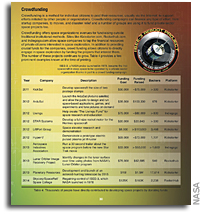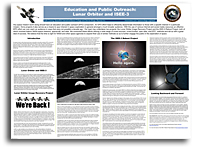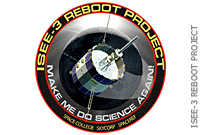 Emerging Space: The Evolving Landscape of 21st Century American Spaceflight, PDF, NASA Office of the Chief Technologist
Emerging Space: The Evolving Landscape of 21st Century American Spaceflight, PDF, NASA Office of the Chief Technologist
“Crowdfunding offers space organizations avenues for fundraising outside traditional institutional methods. Sites like Kickstarter.com, Rockethub.com, and Indiegogo.com allow space companies to tap the financial resources of private citizens interested in space exploration. In addition to providing crucial funds for the companies, crowd funding allows citizens to directly engage in space exploration by funding the projects that interest them. The number of these projects continues to grow. Table 4 provides a few prominent examples known at the time of printing. … ISEE-3, a NASA probe launched in 1978, became the first spacecraft in deep space to be operated by a private-sector organization thanks in part to a crowd funding campaign.”
Note: When you add ISEE-3 Reboot Project ($160K) and Lunar Orbiter Image Recovery Project ($62K) together (both conducted by the same team) over $222,000 has been raised via crowdfunding. Click on image to enlarge.
Education and Public Outreach: Lunar Orbiter and ISEE-3
 This poster presentation by Keith Cowing and Dennis Wingo was produced for the NASA SSERVI Exploration Science Forum 21-23 July 2014. Click on image for full poster (PDF)
This poster presentation by Keith Cowing and Dennis Wingo was produced for the NASA SSERVI Exploration Science Forum 21-23 July 2014. Click on image for full poster (PDF)
Introduction
Any space mission worth doing should have an education and public outreach (EPO) component. An EPO effort helps to efficiently disseminate information to those with a specific interest in a particular mission. Done properly it also serves as a means to spur interest in space exploration in general amongst a much broader audience. With the use of various Internet and social media resources an effective EPO effort can now reach an audience in ways that were not possible a decade ago.
Continue reading “Education and Public Outreach: Lunar Orbiter and ISEE-3”
McMoons, LOIRP, and ISEE-3 Make Front Page of the New York Times
 Calling Back a Zombie Ship From the Graveyard of Space, New York Times (front page story)
Calling Back a Zombie Ship From the Graveyard of Space, New York Times (front page story)
“For 17 years, [ISEE-3] has been drifting on a lonely course through space. Launched during the disco era and shuttered by NASA in 1997, the spacecraft is now returning to the civilization that abandoned it. It seemed destined to pass without fanfare, except for a slight chance of slamming into the moon, and then loop aimlessly through the inner solar system. But now, a shoestring group of civilians headquartered in a decommissioned McDonald’s have reached out and made contact with it — a long-distance handshake that was the first step toward snaring it back into Earth’s orbit. … Mr. Wingo and Keith Cowing, the editor of NASA Watch, a sometimes cantankerous website covering news and gossip about the space agency, had previously collaborated on a project that resurrected equipment to read 50-year-old magnetic tapes, extracting high-resolution images taken by NASA lunar orbiters in the 1960s — a task NASA had also regarded as infeasible. Mr. Wingo and Mr. Cowing decided ISEE-3 was another worthy effort.”
ISEE-3 Reboot Project Is in Command of ISEE-3
 The ISEE-3 Reboot Project is pleased to announce that our team has established two-way communication with the ISEE-3 spacecraft and has begun commanding it to perform specific functions. Over the coming days and weeks our team will make an assessment of the spacecraft’s overall health and refine the techniques required to fire its engines and bring it back to an orbit near Earth.
The ISEE-3 Reboot Project is pleased to announce that our team has established two-way communication with the ISEE-3 spacecraft and has begun commanding it to perform specific functions. Over the coming days and weeks our team will make an assessment of the spacecraft’s overall health and refine the techniques required to fire its engines and bring it back to an orbit near Earth.
First Contact with ISEE-3 was achieved at the Arecibo Radio Observatory in Puerto Rico. We would not have been able to achieve this effort without the gracious assistance provided by the entire staff at Arecibo. In addition to the staff at Arecibo, our team included simultaneous listening and analysis support by AMSAT-DL at the Bochum Observatory in Germany, the Space Science Center at Morehead State University in Kentucky, and the SETI Institute’s Allen Telescope Array in California.
Of course this effort would not have been possible without the assistance of NASA and the Space Act Agreement crafted by NASA Headquarters, NASA Ames Research center, and the System Solar System Exploration Research Virtual Institute (SSERVI).
For further information on the ISEE-3 Reboot Project please visit our website at http://spacecollege.org/isee3 A much more detailed description of our First Contact efforts and future plans will be published on our website next week.
LOIRP Team Announces the ISEE-3 Reboot Project
Our plan is simple: we intend to contact the ISEE-3 (International Sun-Earth Explorer) spacecraft, command it to fire its engines and enter an orbit near Earth, and then resume its original mission – a mission it began in 1978. ISEE-3 was rechristened as the International Comet Explorer (ICE). If we are successful it may also still be able to chase yet another comet.
Working in collaboration with NASA we have assembled a team of engineers, programmers, and scientists – and have a large radio telescope fully capable of contacting ISEE-3. If we are successful we intend to facilitate the sharing and interpretation of all of the new data ISEE-3 sends back via crowd sourcing.
NASA has told us officially that there is no funding available to support an ISEE-3 effort – nor is this work a formal priority for the agency right now. But NASA does feel that the data that ISEE-3 could generate would have real value and that a crowd funded effort such as ours has real value as an education and public outreach activity.
Time is short. And this project is not without significant risks. We need your financial help. ISEE-3 must be contacted in the next month or so and it must complete its orbit change maneuvers no later than mid-June 2014. There is excitement ahead as well: part of the maneuvers will include a flyby of the Moon at an altitude of less than 50 km.
Our team members at Morehead State University, working with AMSAT-DL in Germany, have already detected the carrier signals from both of ISEE-3’s transmitters. When the time comes, we will be using the large dish at Morehead State University to contact the spacecraft and give it commands.
In order to interact with the spacecraft we will need to locate the original commands and then develop a software recreation of the original hardware that was used to communicate with the spacecraft. These are our two greatest challenges.
The funding we seek will be used for things we have not already obtained from volunteers. We need to initiate a crash course effort to use ‘software radio’ to recreate virtual versions all of the original communications hardware that no longer physically exists. We also need to cover overhead involved in operating a large dish antenna, locating and analyzing old documentation, and possibly some travel.
This activity will be led by the same team that has successfully accomplished the Lunar Orbiter Image Recovery Project (LOIRP): SkyCorp and SpaceRef Interactive. Education and public outreach will be coordinated by the newly-formed non-profit organization Space College Foundation.
Our trajectory efforts will be coordinated by trajectory maestro Robert Farquhar and his team at KinetX. We are also working in collaboration with the Science Mission Directorate at NASA Headquarters, NASA Goddard Spaceflight Center, and the Solar System Exploration Research Virtual Institute (SSERVI) at NASA Ames Research Center.
Please consider making a donation to our project by visiting our RocketHub crowdfunding page.
For information contact Dennis Wingo at 310-403-1346 or by email at wingo -at- skycorpinc.com
International Cometary Explorer (ISEE-3) Beacon Signal Detected

“On March 1st and 2nd, 2014 radio amateurs were able to detect the beacon signal from the retired NASA deep space probe ICE (International Cometary Explorer) at the Bochum Observatory (Germany). After some changes to the ground equipment and aligning the receive antenna to the predicted position in the sky, the beacon signal could positively be identified due to its frequency, the position in the sky and the frequency shift due to the radial velocity (Doppler shift). For this detection the 20m radio telescope from the Bochum Observatory was used. In 2003, AMSAT-DL converted this former industrial monument into a fully functional groundstation for deep space probes. Since 2009 the facility is being used by volunteers almost full time as ground receive station for data from the STEREO mission with its two spaceprobes monitoring the sun from different viewing angles.”
– More at AMSAT-DL and Bochum Observatory receive signal from retired NASA spacecraft
– NASA Could Try To Contact ISEE-3/ICE – But It Won’t, earlier post
NASA Could Try To Contact ISEE-3/ICE – But It Won’t
 From the ISEE-3 Returns Facebook page: Communication involves speaking, listening and understanding what we hear. One of the main technical challenges the ISEE-3/ICE project has faced is determining whether we can speak, listen, and understand the spacecraft and whether the spacecraft can do the same for us. Several months of digging through old technical documents has led a group of NASA engineers to believe they will indeed be able to understand the stream of data coming from the spacecraft.
From the ISEE-3 Returns Facebook page: Communication involves speaking, listening and understanding what we hear. One of the main technical challenges the ISEE-3/ICE project has faced is determining whether we can speak, listen, and understand the spacecraft and whether the spacecraft can do the same for us. Several months of digging through old technical documents has led a group of NASA engineers to believe they will indeed be able to understand the stream of data coming from the spacecraft.
NASA’s Deep Space Network (DSN) can listen to the spacecraft, a test in 2008 proved that it was possible to pick up the transmitter carrier signal, but can we speak to the spacecraft? Can we tell the spacecraft to turn back on its thrusters and science instruments after decades of silence and perform the intricate ballet needed to send it back to where it can again monitor the Sun? The answer to that question appears to be no.
The transmitters of the Deep Space Network, the hardware to send signals out to the fleet of NASA spacecraft in deep space, no longer includes the equipment needed to talk to ISEE-3. These old-fashioned transmitters were removed in 1999. Could new transmitters be built? Yes, but it would be at a price no one is willing to spend. And we need to use the DSN because no other network of antennas in the US has the sensitivity to detect and transmit signals to the spacecraft at such a distance.
This effort has always been risky with a low probability of success and a near-zero budget. It is thanks to a small and dedicated group of scientists and engineers that we were able to get as far as we have. Thank you all very much.
